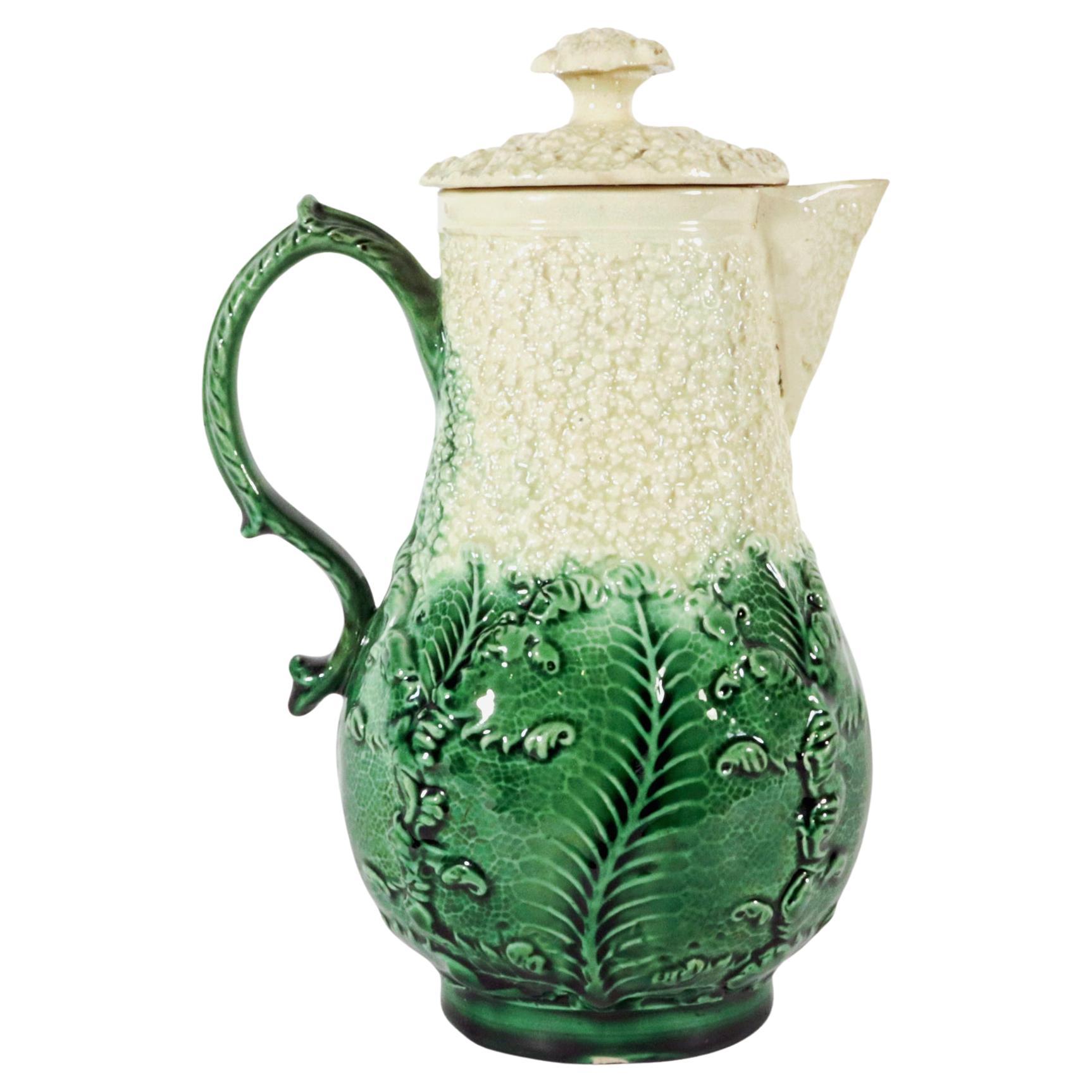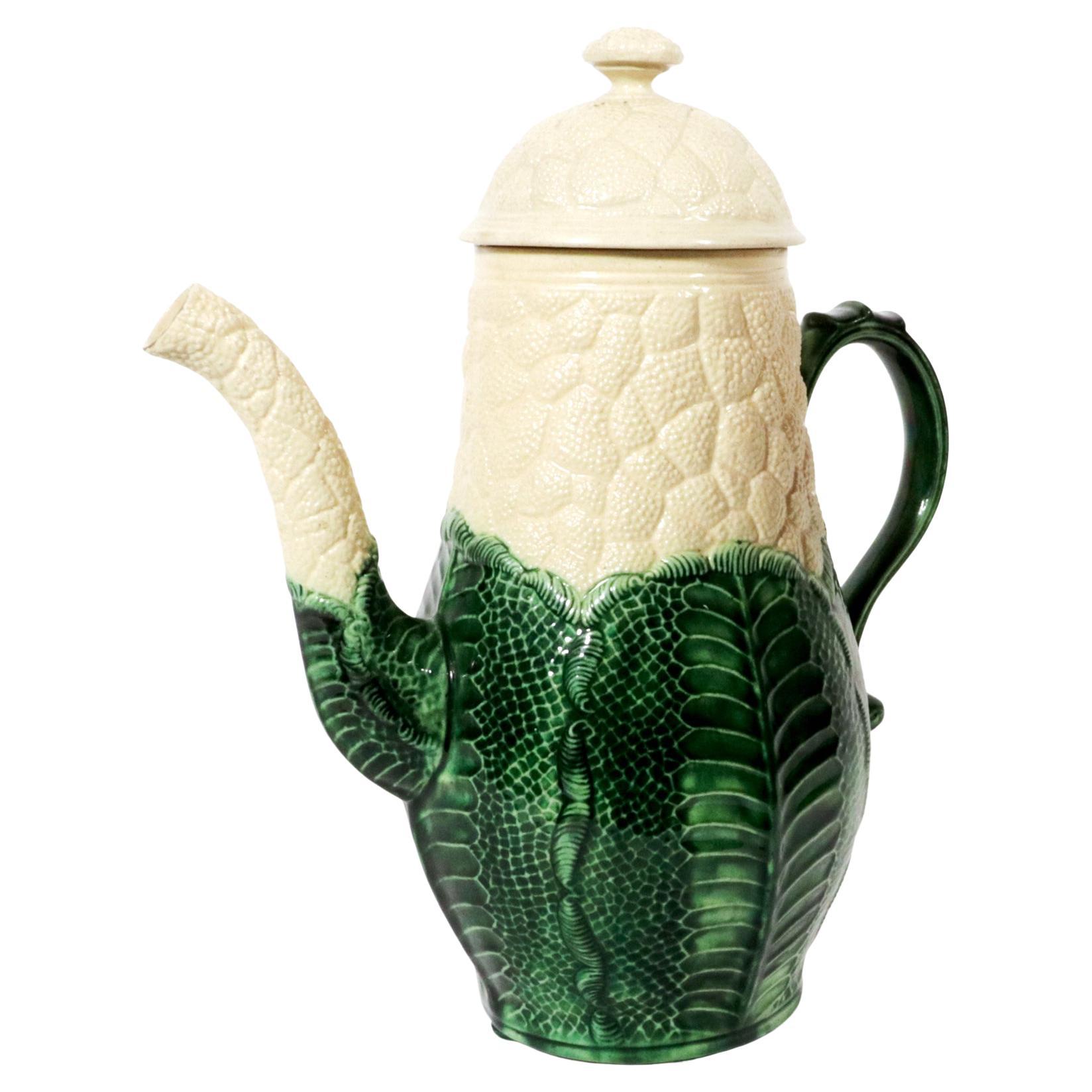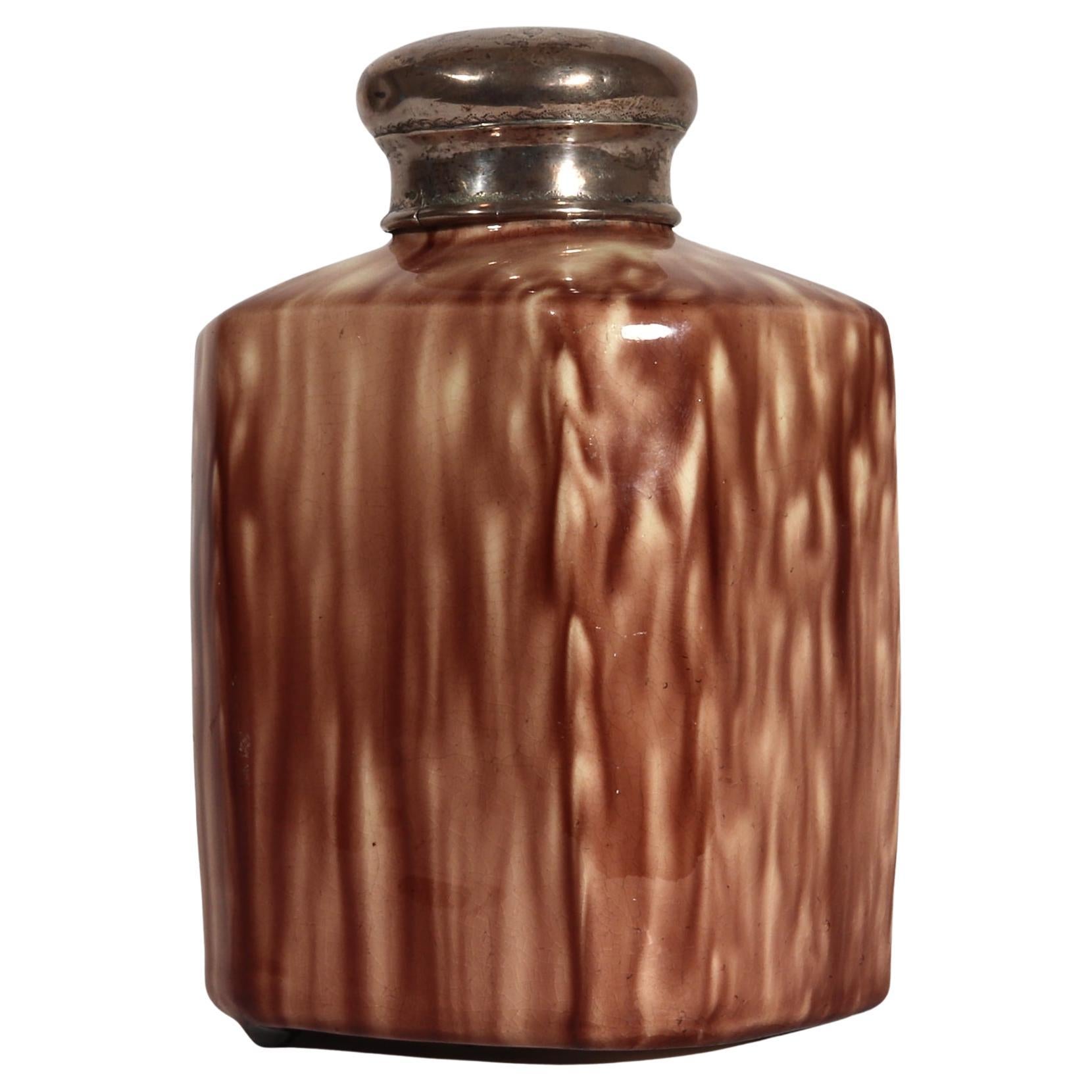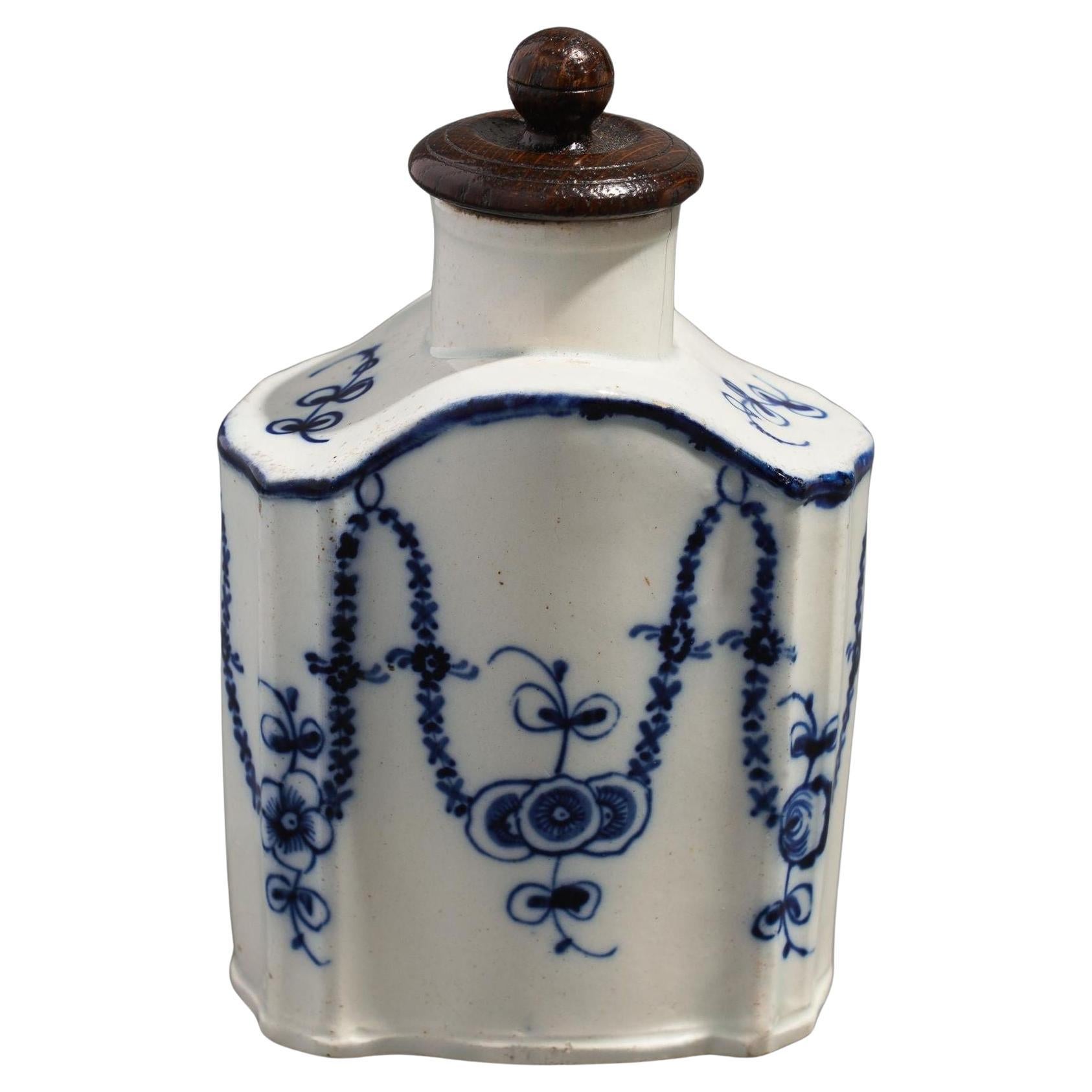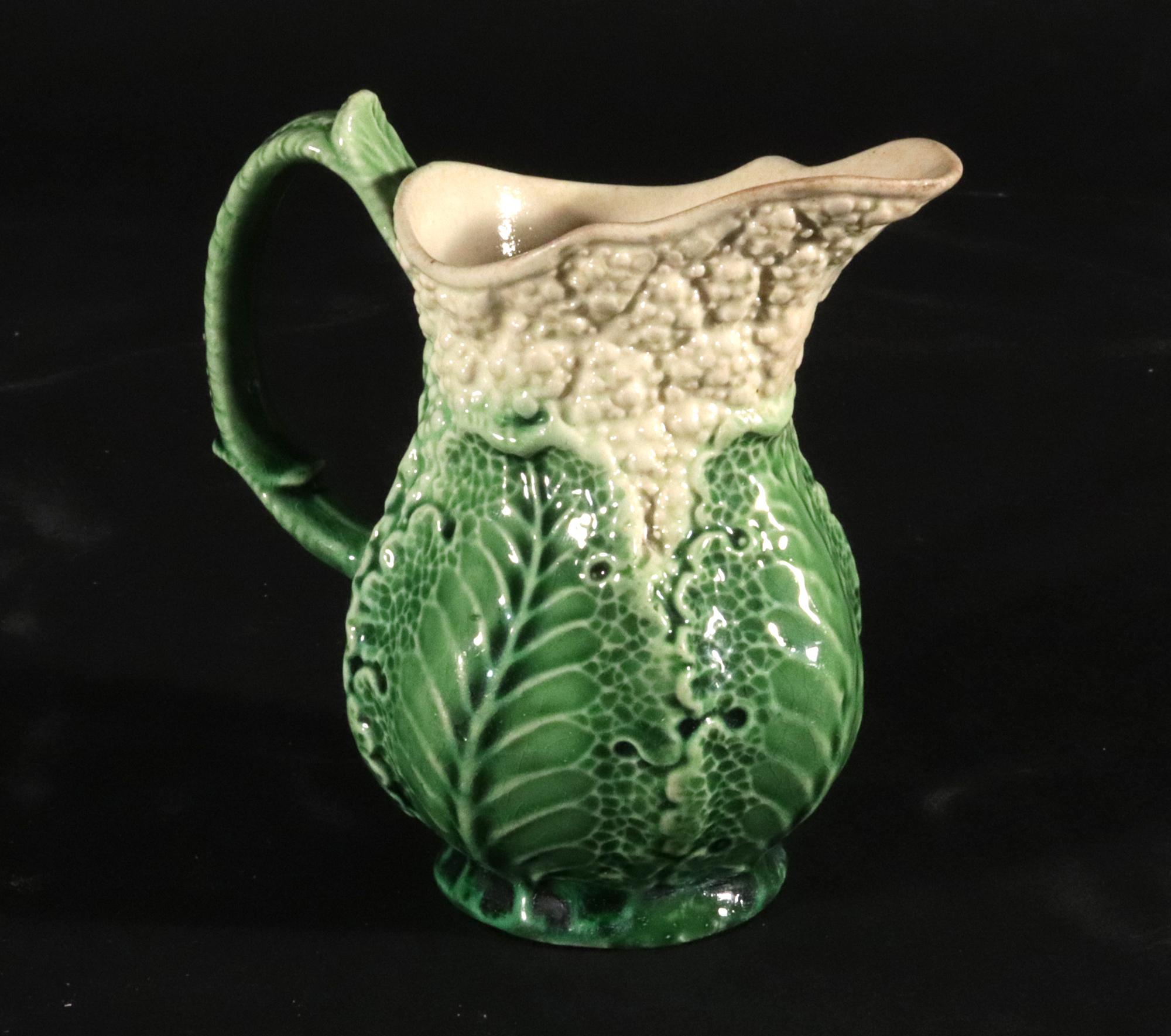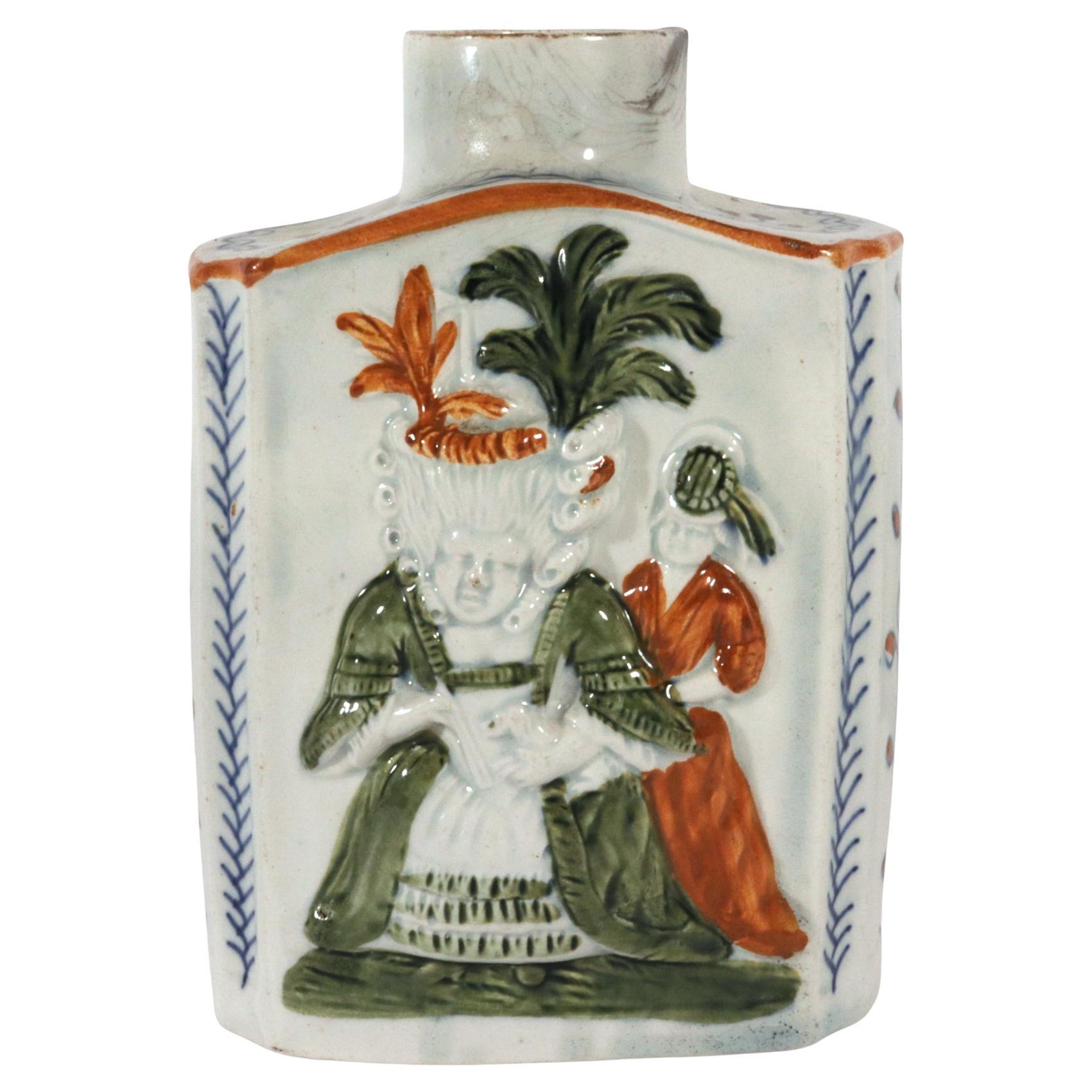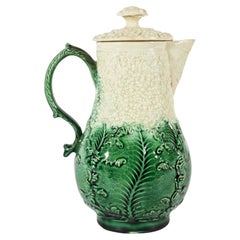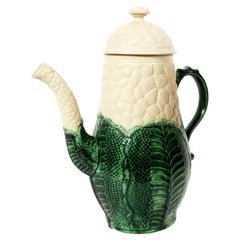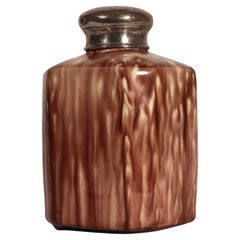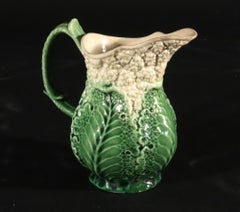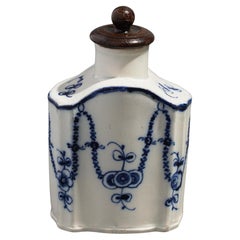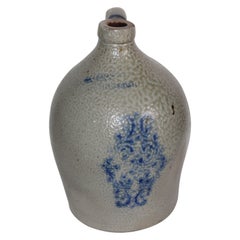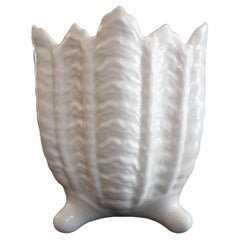Items Similar to 18th Century Staffordshire Creamware Cauliflower Tea Caddy
Video Loading
Want more images or videos?
Request additional images or videos from the seller
1 of 10
18th Century Staffordshire Creamware Cauliflower Tea Caddy
$1,500
£1,145.04
€1,316.30
CA$2,110.77
A$2,347.26
CHF 1,232.83
MX$28,697.63
NOK 15,362.28
SEK 14,482.48
DKK 9,823.85
About the Item
18th Century Staffordshire Creamware Cauliflower Tea Caddy,
Probably by William Greatbach/ Josiah Wedgwood
Lead-glazed earthenware,
Circa 1765
The molded creamware tea caddy has an unusual oval form with two large and two small cabbage leaf designs to the sides. The shoulder with white florets. The base is ungklazed.
Dimensions: 4 inches high x 3 1/2 inches wide x 2 3/4 inches deep
On one side the green glaze does not reach all the way to the base.
Colonial Williamsburg notes that naturalism was an important theme echoed in the decorative arts of the mid-eighteenth century. This fascination with nature was reflected in the types of ceramic wares produced throughout England. Staffordshire potters produced molded tea wares made to mimic the natural world including the coloration of tortoise shell, the look of agate stone, and many fruits and vegetables including cauliflower. This milk jug was made en suite with other cauliflower tea wares.
The green of the leaves was produced through the addition of copper oxide to the surface of the jug and the white of the florets is the natural color of the refined earthenware clay. The entire body is coated in a lead glaze.
(Ref: NY10644-mrrx)
- Attributed to:William Greatbatch (Manufacturer)
- Dimensions:Height: 4 in (10.16 cm)Width: 3.5 in (8.89 cm)Depth: 2.75 in (6.99 cm)
- Style:Georgian (Of the Period)
- Materials and Techniques:
- Place of Origin:
- Period:1760-1769
- Date of Manufacture:1765
- Condition:Wear consistent with age and use.
- Seller Location:Downingtown, PA
- Reference Number:Seller: NY10644-mrrx1stDibs: LU861041938142
About the Seller
5.0
Recognized Seller
These prestigious sellers are industry leaders and represent the highest echelon for item quality and design.
Platinum Seller
Premium sellers with a 4.7+ rating and 24-hour response times
Established in 1916
1stDibs seller since 2009
416 sales on 1stDibs
Typical response time: 3 hours
Associations
The Art and Antique Dealers League of AmericaAntiques Associations Members
- ShippingRetrieving quote...Shipping from: Downingtown, PA
- Return Policy
Authenticity Guarantee
In the unlikely event there’s an issue with an item’s authenticity, contact us within 1 year for a full refund. DetailsMoney-Back Guarantee
If your item is not as described, is damaged in transit, or does not arrive, contact us within 7 days for a full refund. Details24-Hour Cancellation
You have a 24-hour grace period in which to reconsider your purchase, with no questions asked.Vetted Professional Sellers
Our world-class sellers must adhere to strict standards for service and quality, maintaining the integrity of our listings.Price-Match Guarantee
If you find that a seller listed the same item for a lower price elsewhere, we’ll match it.Trusted Global Delivery
Our best-in-class carrier network provides specialized shipping options worldwide, including custom delivery.More From This Seller
View All18th Century Staffordshire Creamware Cauliflower Milk Jug and Cover
By William Greatbatch
Located in Downingtown, PA
18th Century Staffordshire Creamware Cauliflower Ware Milk Jug and Cover,
Probably by William Greatbach/ Josiah Wedgwood
Lead-glazed earthenware,
Circa 1765
The creamware milk jug ...
Category
Antique Mid-18th Century Georgian Pottery
Materials
Creamware, Pottery
English Creamware Pottery Cauliflower Coffee Pot and Cover
By Staffordshire
Located in Downingtown, PA
English Creamware Pottery Cauliflower Coffee Pot and Cover,
Staffordshire,
Circa 1760-70
The lead-glazed earthenware creamware "cauliflower" coffeepot and over has a pear-shaped bo...
Category
Antique 1760s English Georgian Pottery
Materials
Creamware, Pottery
18th Century English Whieldon-Type Creamware Tortoiseshell Glaze Tea Caddy
By Thomas Whieldon Pottery
Located in Downingtown, PA
English Creamware Tortoiseshell glaze tea caddy,
Whieldon-type,
With Silver Cover,
circa 1770
The creamware large tea caddy has a tortoiseshell d...
Category
Antique 1760s English Georgian Pottery
Materials
Creamware, Pottery
18th-century Staffordshire Creamware Cauliflower Creamer
By William Greatbatch
Located in Downingtown, PA
18th-century Staffordshire Creamware Cauliflower Creamer Jug,
Probably by William Greatbach/ Josiah Wedgwood
Lead-glazed earthenware,
Circa 1765
The creamware creamer jug has a bal...
Category
Antique 1760s English Georgian Tableware
Materials
Creamware, Pottery
Prattware Pottery Macaroni Tea Caddy, Possibly Prestonpans. Scotland
Located in Downingtown, PA
Prattware English Pottery Pearlware Tea Canister,
Macaroni Figures,
Possibly Bankfoot pottery, Prestonpans. Scotland or Staffordshire,
Circa 1790-1800.
The pearlware pottery tea caddy is decorated with Macaroni figures. On one side is depicted a gentleman wearing an exaggeratedly high wig with his servant standing beside him. On the other side is a similarly caricatured lady and her servant.
Dimensions: 5 inches High x 3-1/4 inches Wide x 2 inches Deep.
Condition: Glaze imperfection to neck.
The caddy was possibly made in Scotland at Prestonpans where plaster of Paris moulds were recovered during excavations.
Plaster of Paris moulds recovered during excavations below the floor of the Belfield Pottery in Prestonpans and almost certainly dumped from the earlier Bankfoot pottery.
The figures are modelled in very full relief and painted in green and brown. The narrow sides of the tea caddy are painted with a flowering vine. In the canted corners of the caddy is a wavy underglaze blue line.
During the 18th century, "macaroni" was the satirical term for men who sported elaborate clothing and continental affectations. Lampooning various occupations and specific styles, these are reproductions of period cartoons.
These amusing figures are after English caricatures produced between 1765 and 1790. The satirical jibes were directed at the young moderns of the time, known as "macaronies."
A group of privileged young Englishmen adopted styles and manners they had admired during their travels in Italy and France. They formed the Macaroni Club (macaroni being virtually unknown in England at the time), an eating club where they vied with one another in matters of dress and manners. Extremes developed and soon spread into larger society. With ribbon-and-lace festooned clothing, prim-verging-on-prissy manners and absurd coiffures, macaronies (both male and female) were subjects of ridicule.
Provenance: Private Maine Collection
Reference:
Haggarty, G 2010 ‘The Belfield Pottery Production Site Ceramic Resource Disk: The Northern Ceramic Society Journal Vol 26 (2009-10), 142-3 + CD ROM.
Pratt Ware: English and Scottish relief decorated and underglaze coloured earthenware, 1780-1840, John and Griselda Lewis, Page 234.
Earle: The Earle Collection of Early Staffordshire Pottery...
Category
Antique Early 19th Century Scottish Georgian Pottery
Materials
Pearlware, Pottery
American Etruscan Majolica Teapot in the Form of a Cauliflower
Located in Downingtown, PA
American Etruscan Majolica Teapot in the form of a Cauliflower,
Early Majolica-type body,
Circa 1860
The green molded tromp L'oeil teapot is des...
Category
Antique 1860s American American Craftsman Pottery
Materials
Majolica
You May Also Like
Leeds pearlware shaped creamware tea caddy, c. 1780
Located in Kenilworth, IL
Antique Bombay shaped English pearlware tea caddy with a distinctive decoration in blue cobalt. The caddy is hand decorated with flower pendants draped from rings painted from a cont...
Category
Antique Late 18th Century British Tea Caddies
Materials
Earthenware, Wood
18th Century Faience Pot With Lid
Located in Charlottesville, VA
A nice collectors piece. With attached pewter lid.
Category
Antique 18th Century Serving Pieces
Materials
Ceramic
19thc Stoneware jug, Cowden and Wilcox
Located in Los Angeles, CA
Snow flake pattern
Category
Antique 19th Century American Adirondack Pottery
Materials
Pottery
$1,160 Sale Price
20% Off
COALPORT - Country Ware - Vintage Bone China Planter - U.K. - Late 20th Century
By Coalport Porcelain
Located in Chatham, ON
COALPORT - Country Ware - Vintage white bone china planter - featuring overlapping leaves to the exterior - the leaf tips forming the rim - glazed finish - printed mark on the base -...
Category
Late 20th Century English Victorian Planters, Cachepots and Jardinières
Materials
Ceramic
Antique Lovely Lidded Jug Qing Porcelain Chine de Commande Sepia, 18th C
Located in Amsterdam, Noord Holland
A rare, good conditioned, and quality painting Lidded jug.
Very nicely decorated piece with good details. Blue and sepiacentral sepia reserve "European village". Lid has a sepia lan...
Category
Antique 18th Century Chinese Pitchers
Materials
Porcelain
$946 Sale Price
20% Off
c. 1720 Kangxi or Yongzheng Period Porcelain Tea Caddy
Located in Chapel Hill, NC
Circa 1720 Kangxi or Yongzheng period porcelain tea caddy, Chinese. Elegant & profusely decorated blue & white porcelain with later tole cover. 8-sided, underglaze floral decoration ...
Category
Antique Early 18th Century Chinese Chinese Export Porcelain
Materials
Porcelain
$396 Sale Price
20% Off
More Ways To Browse
Georgian Copper
Antique Glass Milk Jugs
Green Tortoise
White Tortoise
Williamsburg Colonial
Silver Coated Shell
Antique Tortoise Shell Glasses
Antique Clay Jug Jugs
Large Copper Jug
Georgian Agate
Ceramic Tortoise
Antique Copper Tea Caddy
Tortoise Shell Tea Caddy
Antique Copper Milk Jug
Williamsburg Pottery
Ceramic Tea Caddy
Wedgwood Cabbage
Wedgwood Cauliflower
